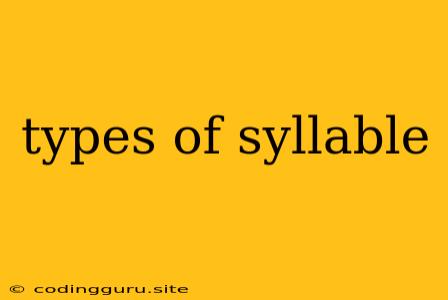Understanding the Building Blocks of Speech: Exploring Different Types of Syllables
Syllables are the fundamental units of spoken language. They are the building blocks that make up words and, in turn, sentences. But what exactly is a syllable? And how many different types of syllables are there? This article delves into the fascinating world of syllables, exploring the different types and their impact on pronunciation and language understanding.
What is a Syllable?
A syllable is a single, uninterrupted unit of sound that forms a word. It typically consists of a vowel sound, which is often accompanied by one or more consonant sounds. The vowel sound acts as the core of the syllable, while the consonant sounds surround it. For instance, the word "cat" contains one syllable, with the vowel "a" being the core.
Types of Syllables
While the core of a syllable is the vowel sound, the arrangement of consonants and vowels within a syllable can vary, leading to different types of syllables:
1. Open Syllable: An open syllable ends with a vowel sound. It does not have a consonant sound after the vowel. Think of the word "go" where the vowel "o" is not followed by a consonant. Other examples include "he," "we," and "my."
2. Closed Syllable: A closed syllable ends with a consonant sound. This consonant sound follows the vowel sound. For instance, the word "cat" ends with the consonant "t" after the vowel "a." Other examples include "dog," "run," and "sun."
3. R-Controlled Syllable: An R-controlled syllable is a closed syllable where the vowel sound is influenced by the "r" sound that follows it. This means that the vowel sound doesn't have its typical pronunciation. Take the word "car" as an example. The "a" sound is not the same as in "cat" but instead, it is affected by the "r" sound. Other examples include "bird," "fur," and "stir."
4. Diphthong Syllable: A diphthong syllable contains a diphthong, which is a combination of two vowel sounds within a single syllable. Think of the word "boy." It contains the diphthong "oy," where the vowel sound shifts from "o" to "i." Other examples include "cow," "house," and "now."
5. Triphthong Syllable: A triphthong syllable contains a triphthong, a combination of three vowel sounds. These are relatively rarer than diphthongs and can be challenging to pronounce. The word "fire" is an example of a triphthong syllable, containing the triphthong "i-ə-r."
Identifying Syllables
Identifying syllables in words is crucial for pronunciation and spelling. Here are some helpful tips:
- Listen for the vowel sounds: Each vowel sound typically forms the core of a syllable.
- Look for consonant blends: Consonant blends can act as a single sound, forming part of a syllable.
- Pay attention to vowel digraphs: Vowel digraphs, like "ai" or "ou," can represent a single vowel sound, forming the core of a syllable.
- Divide words into syllables: Divide words at the point where the vowel sound shifts or changes.
Importance of Syllable Types
Understanding the different types of syllables is important for several reasons:
- Pronunciation: Knowing the types of syllables helps us pronounce words correctly. For example, recognizing an R-controlled syllable can help us correctly pronounce the vowel sound.
- Spelling: The types of syllables can influence the spelling of words. For instance, understanding open syllables helps us know when to double consonants.
- Language Learning: Recognizing syllables helps us break down words and understand their meaning.
- Poetry and Rhyming: Syllable count is essential in poetry and rhyming, as it helps determine the rhythm and flow of the verse.
Examples of Syllable Types in Different Languages
Syllable types are not limited to English. They are a fundamental element of language structures across the globe.
- Spanish: Spanish often uses open syllables, resulting in a more melodic and flowing pronunciation.
- French: French features many closed syllables, particularly when the "e" sound is present.
- Japanese: Japanese syllable structure is based on morae, which are similar to syllables but with a different system of counting.
Conclusion
Syllable types provide a framework for understanding the structure of spoken words. They influence pronunciation, spelling, and language learning. By recognizing different types of syllables, we gain a deeper appreciation for the intricacies of spoken language and the fascinating world of phonetics.
